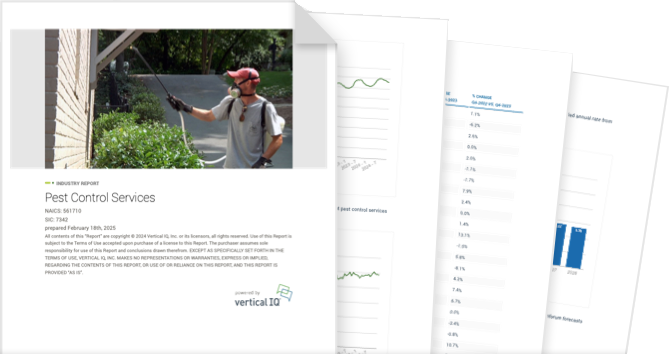Commercial Property Managers NAICS 531312

Unlock access to the full platform with more than 900 industry reports and local economic insights.
Get access to this Industry Profile including 18+ chapters and more than 50 pages of industry research.
Industry Summary
The 15,914 Commercial property management companies in the US maintain and manage real estate assets, such as office buildings, industrial buildings, warehouses, and other nonresidential buildings. Firms generate the majority of revenue from property management services, which include general maintenance, engineering, operations, landscaping, janitorial, and sustainability services.
Dependence on Subcontractors
Commercial property managers typically rely on subcontractors for certain types of services, such as plumbing and electrical repair, HVAC maintenance, or waste pick-up.
Competition from Property Tech
Advances in real estate and property tech have made property self-management less complex and more feasible for commercial real estate (CRE) owners.
Recent Developments
Dec 15, 2025 - Outlook for Office Demand Remains Cloudy
- The US office market’s recovery remains uneven amid high vacancy rates and declining property values in some markets, according to The Wall Street Journal. While districts like New York’s Park Avenue and San Francisco’s South of Market show signs of strength, most markets struggle with empty space due to structural shifts from remote and hybrid work. Companies are downsizing footprints, leaving landlords, lenders, and local governments under pressure as office-related tax collections fall. Some investors remain cautious, with office property sales far below pre-pandemic levels, though conversions to housing and limited new supply are tightening prime space in select areas. With AI-driven job cuts adding uncertainty, analysts warn the slump may not mirror past cycles, raising questions about the long-term viability of traditional office demand.
- Commercial real estate remains out of favor with investors, who have been burned by falling property values, even as the Federal Reserve has repeatedly cut rates, according to The Wall Street Journal. Institutional buyers, once the backbone of the market, have reduced their allocations as returns have lagged far behind those of equities, infrastructure, and commodities. US property values remain 17% lower than their 2022 peaks, with offices and apartments hit the hardest, according to Green Street. While opportunistic firms like RXR and Blackstone are acquiring discounted assets, many investors are hesitant to invest in refurbishments. Amid the demise of cheap debt and the assumption of rising property values, income generation from property is becoming increasingly important, shifting the focus to assets such as senior housing, retail, and high-quality offices. With construction costs up more than 40% since 2020, the limited new supply could drive rent growth.
- Industrial real estate is showing signs of stabilization, with climbing demand and a shrinking supply pipeline helping to ease vacancy pressures, according to Supply Chain Dive. Colliers reports Q3 net absorption increased by 20 million square feet year over year and was the strongest since Q1 2023. Companies are increasingly comfortable making long-term decisions, despite tariff-related uncertainty, according to Prologis President Dan Letter. Ecommerce and supply chain investments are driving demand as firms aim to improve service while reducing costs. Letter noted that large, well-capitalized companies are leading the way, often followed by smaller businesses. Meanwhile, Colliers reports that industrial space under construction fell to 270 million square feet in Q3, the lowest since 2018. Despite this, markets like Dallas-Fort Worth and Houston are seeing construction growth amid consistent tenant demand.
- US office vacancies dropped to 18.8% in Q3 from 19% a year earlier, marking the first year-over-year decline since the pandemic, according to CBRE and reporting by Facilities Dive. Vacancies are falling amid a drop in new construction and the conversion or demolition of older spaces. Leasing activity rose 15% over Q2 2025 and 11% year over year. However, average lease size in Q3 was down 24% from pre-pandemic levels, partly due to the prevalence of hybrid work. Small occupiers led demand, with leases between 10,000 and 20,000 square feet making up 56% of year-to-date activity. Remote-heavy markets such as Washington, DC, Boston, and Seattle saw demand surge, while traditional hubs like New York and Chicago declined. Prime buildings outperformed, with vacancy spreads widening. Average rents rose 1.7% to $32.47 per square foot, though inflation-adjusted asking rents remain at their lowest since 1988.
Industry Revenue
Commercial Property Managers

Industry Structure
Industry size & Structure
The average commercial property management firm operates out of a single location, employs about 11 workers, and generates $2.8 million annually.
- The commercial property management industry consists of 15,914 firms that employ 173,500 workers and generate about $44 billion annually.
- The industry is concentrated at the top and fragmented at the bottom; the top 50 companies account for 47% of industry revenue. About half of all firms generate less than $500,000 annually.
- Large firms with commercial property management operations include CBRE, JLL, and Cushman and Wakefield. Large firms often have global operations.
Industry Forecast
Industry Forecast
Commercial Property Managers Industry Growth

Vertical IQ Industry Report
For anyone actively digging deeper into a specific industry.
50+ pages of timely industry insights
18+ chapters
PDF delivered to your inbox
